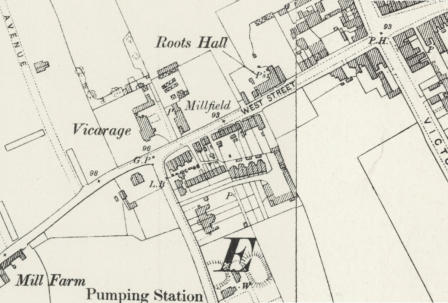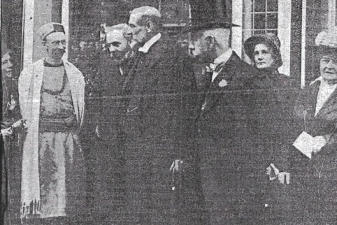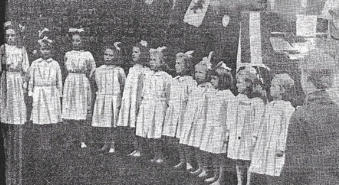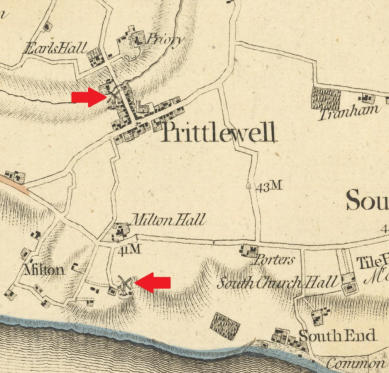Millfield
This
drawing
by
Miss
Norah
Arber
shows
a
smock
windmill
that
stood
on
a
plot
of
land
called
Millfield
on
West
Street,
Prittlewell,
and
as
it
existed
in
the
period
between
1832
and
1865.
St
Mary's
church
can
be
seen
to
east
in
the
background
and
the
building
behind
the
mill
to
its
right
was
Millfield
House.
West
Street
is
out
of
view,
to
right
of
Millfield
House
and
off
the
right
edge
of
the
drawing.
Today
the
site
of
this
mill
would
be
the
M&S
petrol
station on the west side of Roots Hall Drive.
There
have
been
several
windmills
in
the
Southend
area.
The
oldest
that
is
implied
in
the
records
was
Hamlet
Mill
which
stood
on
the
south
side
of
what
is
now
the
junction
of
Avenue
Road
and
Park
Road
in
Westcliff.
This
served
the
Milton
Hall
Estate
and
a
mention
of
'Mildentuna'
in
the
Domesday
Book
of
1086
would
mean
'Hamlet
by
a
mill'
in
old
English
although
some
modern
sources
give
the
origins
of
the
name
'Milton'
as
'middle
town'.
There
is
a
record
of
a
new
mill
being
built
on
the
site
in
1299
which
implies an older mill existed there.
The
earliest
recorded
mill
in
Prittlewell
was
built
by
Richard
De
Southchurch
in
1294.
This
stood
on
the
north
side
of
the
junction
of
East
Street
and
Sutton
Road,
behind
the
workhouse
cottages
which
were
also
known
as
'Mill
Hill
Cottages'.
The
cottages
were
demolished
in
1960
and
are
now
a
block
of
flats.
Another
windmill
was
built
in East Street in 1779 but demolished in 1870.
The
1777
'Map
of
the
County
of
Essex'
by
John
Chapman
&
Peter
André
was
the
earliest
map
of
the
area
that
can
be
considered
as
accurate
in
terms
of
both
distance
measurements
and
the
buildings
depicted.
The
map
shows
two
mills,
firstly
the
Hamlet
Mill
which
served
the
Milton
Hall
Estate
and
secondly
a
mill
in
Prittlewell,
serving
the
Priory
Estate.
Both
estates
were
owned
by
the
Scratton
family
in
this
period.
The
map
shows
the
importance
of
North
Road
in
connecting
Milton
Hall
and
the
Priory
together
with
their
respective mills.
The
Prittlewell
mill
shown
on
the
1777
map
was
situated
between
Prittle
Brook
and
West
Street,
where
the
Roots
Hall
football
ground
is
today.
It
was
a
post
mill
(where
the
whole
building
could
be
turned
to
face
the
wind)
and
there
is
a
record
of
a
post
mill
in
this
area
from
1758.
This
mill
is
thought
to
have
been
moved
to
a
new
site,
by
West
Street,
in
1794
and
a
mill
at
the
Millfield
site
is
shown
on
an
1825
map.
This
was
demolished
in
1832,
to
be
replaced
by
a
smock
mill
(where
only
the
top
of
the
mill
was
turned
to
face
the
wind).
This
smock
mill
is
the
one
that
is
depicted
in
Miss
Arber's
drawing.
In
addition
to
grinding
corn,
the
mill
is
said
to
have
pumped
water
to a nursery with greenhouses at the rear of Millfield House.
The
arrival
of
the
railway
in
Southend
in
1856
triggered
two
events.
Firstly,
Daniel
Robert
Scratton
decided
to
sell
much
of
his
land
and
retire
to
an
estate
in
Devon.
Secondly,
the
railways
provided
a
fast
means
of
transporting
grain
inland
and
the
barge
owners
were
no
longer
needed
to
transport
grain
along
the
Thames,
with
some
switching
to
coal
transportation
instead.
Combined
with
the
fact
that
wind
power
had
largely
been
superseded
by
the
Industrial
Revolution,
the
small,
local
windmills
were
giving
way
to
larger,
industrial
mills.
The
Hamlet
Mill
was
amongst
the
properties
sold
by
Scratton
in
a
grand
sale
of
1869.
This
land
was
also
called
Millfield
(or
Mill
Fields)
It
was
the
only
decision
by
Scratton
that
proved
unpopular
as
the
iconic,
if
out-dated,
structure
was
demolished shortly after the sale when the land was developed by Thomas Dowsett as the residential Park Estate.
But
Scratton
had
other
plans
for
Prittlewell
where
he
retained
the
land
around
the
Priory
together
with
the
land
granted
to
St
Mary's
Church
and
its
school
at
Glynds,
to
protect
these
from
development.
In
1865,
Scratton
built
a
new
vicarage
for
St
Mary's
Church
on
the
west
side
of
Millfield
House
in
West
Street.
Some
sources
give
the
demolition
of
the
Millfield
Mill
as
c.1869
but
given
the
little
space
that
existed
between
Millfield
House
and
the
new
rectory,
the
mill
was
probably
demolished
in
the
1865
works.
The
new
rectory
replaced
the
old
vicarage
that
stood
by
the
church
on
East
Street.
The
older
building
was
then
rebuilt
and
extended
whereupon
the
school
at
Glynds
(the
foot
of
the
hill
at
the
junction
with
Priory
Crescent
today)
moved
into
the
new
building
as
St
Mary's
School
in
1868.
Scratton
then
sold
the
old
Glynds
building
as cottages.
The
1897
map
shows
the
vicarage
standing
next
to
Millfield
House
(then
called
simply
'Millfield')
on
West
Street.
Another
legacy
of
the
mill
can
be
seen
in
the
name
of
Mill
Farm
(bottom
left
on
the
map).
It
is
also
interesting
that
water
pumping
stations
were
built
close
to
the
sites
of
both
Hamlet
and
Millfield
windmills
given
that
the
latter
was
thought
to
have
also
pumped
water.
The
town's
first
water
supply
had
resulted
from
a
collaboration
between
Daniel
Robert Scratton and the railway company, also in 1865.
Following
Scratton's
death
in
1902,
his
family
began
to
sell
more
of
his
land.
Millfield
House
was
sold
in
1906
and
at
some
stage
was
acquired
by
the
Salvation
Army
to
accommodate
the
court
welfare
work
with
children
and
families
that
had
been
started
by
Mrs
Colonel
Minnie
Clinton
Lamb
in
Southend,
where
she
served
as
a
Poor
Law
guardian
and
probation
officer
as
well
as
being
a
JP.
Mrs
Lamb's
husband,
Colonel
David
Lamb,
had
been
the
governor
of
the
Hadleigh
Farm
Colony.
Minnie
Lamb
turned
Millfield
House
into
a
children's
home
to
provide
an
alternative
to
the
Rochford
Union
workhouse.
As
such
it
replaced a home that she had been running since 1903.
The
Millfield
House
home
was
officially
opened
on
14th
April
1917
by
famous
author
Sir
Henry
Rider
Haggard.
As
H.
Rider
Haggard,
he
was
a
prolific
writer
with
many
novels
about
South
Africa
where
he
had
lived
and
worked
(including
"King
Solomon's
Mines",
its
sequel
"Allan
Quatermain"
and
"She").
But
he
also
wrote
many
letters
to
the
Times
along
with
non-fiction
works
about
social
issues
including
Dr.
Barnardo's
homes
and
the
children's
legislation
of
the
day.
In
particular,
he
had
served
on
a
government
commission
to
examine
the
Salvation
Army Colonies and had written about the Hadleigh Colony.
Two
photos
of
the
1917
opening
were
printed
in
the
Southend
Gazette.
One
shows
H.
Rider
Haggard
with
David
and
Minnie
Lamb
together
with
a
missionary
from
China
(in
the
tasselled
robe).
The
other
shows
a
group
of
the
home's
children
who
sang at the opening.
The
Millfield
House
home
(also
called
simply
Millfields)
was
extended
in
1922
and
again
in
1938
whereupon
the
newly
altered
building
was
re-opened
by
General
Evangeline
Booth
on
23
July
1938.
Minnie
Lamb
died
in
the
same
year.
During
World
War
2
the
residents
were
evacuated
to
Bromsgrove
in
Worcestershire.
Following
David
Lamb's
death
in
1951,
Millfield
House
became
an
Eventide
home
for
women.
Its
new
residents
had
previously
been
living
at
Buzzacott
Hall
in
Wokingham,
Berkshire.
It
continued
to
be
run
by
the
Salvation
Army
and
an
inscription
above
the
door
read
"The
Minnie
Lamb
Memorial
Home".
By
1991,
the
accommodation
at
Millfield
House
was
considered
unsatisfactory
and
it
was
then
rebuilt
as
the
Salvation
Army
administered
care
home,
"Bradbury
Home",
that
stands
there
today.
The
building
takes
its
name
from
the financial support provided by the Bradbury Trust. Bradbury Home was officially opened by Sir Teddy Taylor MP, 15th May 1992.
David and Minnie Lamb were both buried in a family plot at Leigh Cemetery.

Southend Timeline Southend-on-Sea © 2009 - 2024. All Rights Reserved



SOUTHEND CITY

Prittlewell




1897 Map
Millfield
(long
ago)
Norah
Arber.
Picture
from
the
Terry
Herbert
Collection
1777
'Map
of
the
County
of
Essex'
by
John
Chapman
&
Peter
André
Millfield Home Opening 1917 Southend Gazette
Millfield The Homes Children 1917 Southend Gazette

Southend-on-Sea’s No 1 History Website! Documenting The Town & The Townspeople
Now Incorporating The Sea Of Change Website
Website Info:


Chalkwell ▪ Eastwood ▪ Leigh-on-Sea ▪ Prittlewell ▪ Shoeburyness ▪ Southchurch ▪ Thorpe Bay ▪ Westcliff-on-Sea
































































